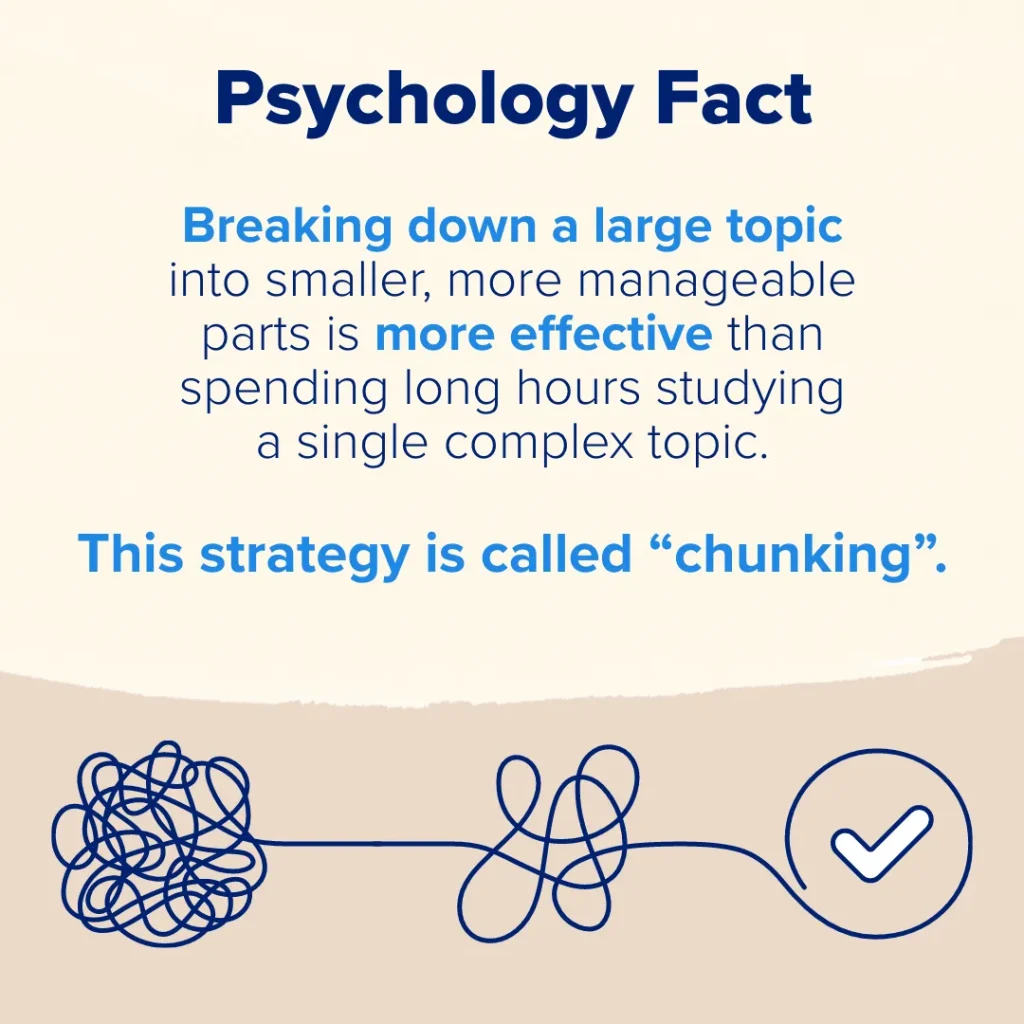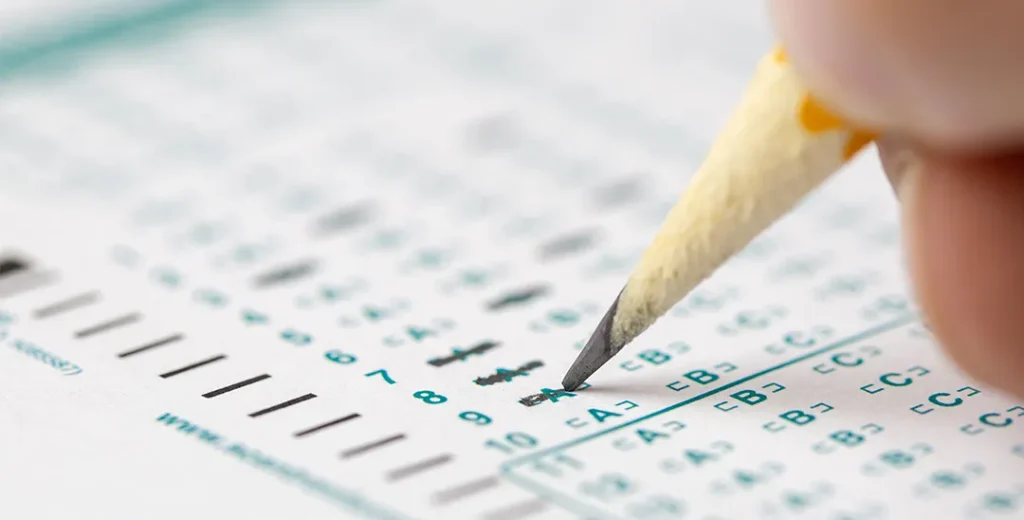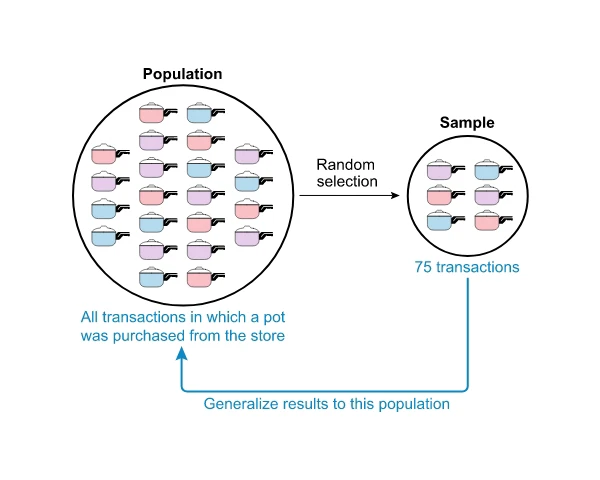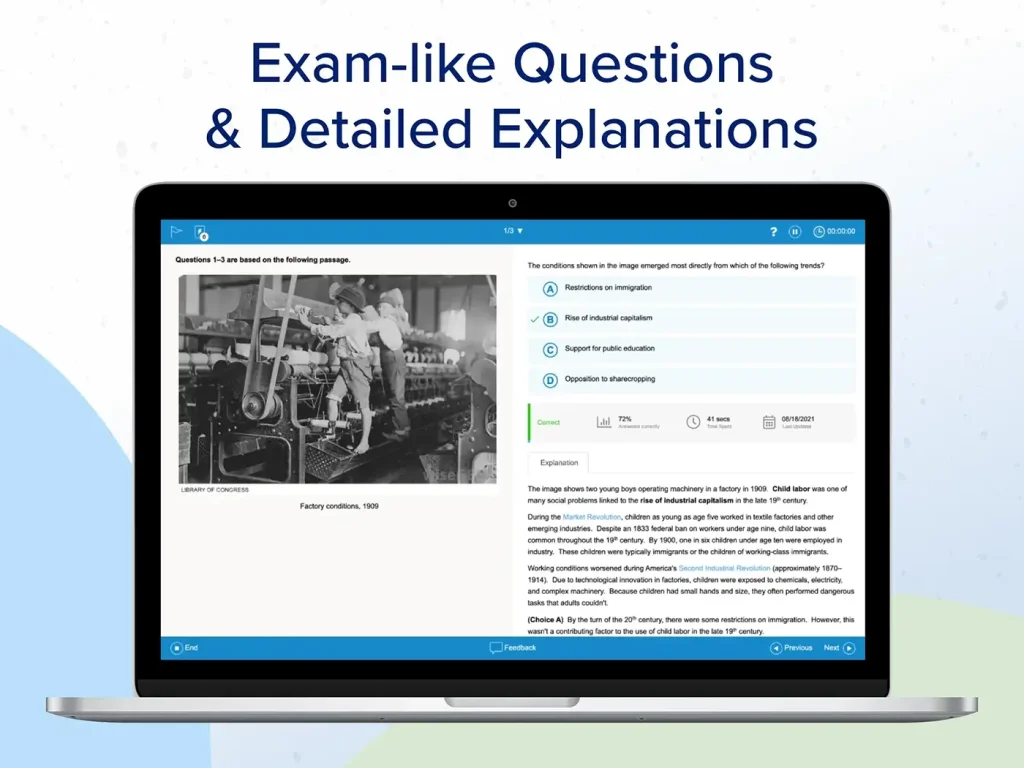Every teacher knows that the last month or so before a summative exam is “go time” for intense content spiraling and test preparation. It’s a time dedicated to reviewing every topic covered, working through a plethora of practice questions, and doing everything possible to make sure students are ready for test day. This is especially true for AP® Statistics teachers because the test has a reputation for being pretty difficult to pass. According to a score distribution report1 by the College Board®, just 60.5% of students who took the AP Statistics test in 2022 got a passing score of 3 or above.

Student Score Distributions on AP exams (2022)
To ensure your students have the best chance possible for a 3 or higher on the test, you need to make sure any last-minute AP Statistics review during the final stretch is on point. Here are five tips for last-minute test preparation ideas you can try with your students!
Tip 1: “Chunk” Curriculum into Smaller, Doable Parts
The main reason for a few final weeks of AP Statistics exam preparation is to spiral through all of the important concepts that have already been covered and may be tested. But when there isn’t much time before the test, it can be hard to cover all of the course material needed to make sure that students are ready. Research shows that “chunking” study topics into smaller sections is a more effective strategy for learning.
According to an Educational Psychology Review study2, breaking down information into smaller, more manageable parts can help students better understand the material and, as a result, feel more confident about it. Instead of trying to tackle an entire AP Statistics unit or concept in one review session, teachers can break it down into smaller sections and work on each one separately. This lets students focus on one topic at a time and helps them remember what they’ve learned better.

Journal of Educational Psychology Review
In addition to breaking information into smaller pieces, AP Statistics teachers can also use “interleaving” as a way to help students prepare for tests. This involves studying multiple related topics in a single study session, rather than focusing on one topic at a time. Research shows that mixing things up helps students tell the difference between ideas that are similar and use their knowledge better.2 By including these strategies in their test preparation plans, AP Statistics teachers can help students feel more confident and prepared for the AP Statistics exam.
Our Choice for a Last-Minute AP Statistics Review Guide: Stats Medic
The Stats Medic AP Exam Review Planning Guide is our pick for a great study guide teachers can use while planning out their last-minute AP Statistics review.
Why We Chose It:
- Offers a customizable study plan for each teacher’s AP Statistics exam prep needs
- Includes a wide range of review materials, including course outlines, practice quizzes, and video lectures
- Provides helpful AP Statistics exam tips and strategies for approaching different types of exam questions
- Includes detailed explanations of key concepts and topics tested on the AP Statistics exam
Tip 2: Practice with Released Exam Questions
One of the best ways AP Statistics teachers can help their students get ready for the test is by having them practice with released test questions. Researchers from the University of Nebraska-Lincoln did a meta-analysis3 that showed that using realistic test prep questions raised test scores by an average of 15 percentile points, while programs that were not similar to the actual test only raised scores by 6 percentile points. And simply put, questions can’t get any more realistic than the ones used from actual past assessments.
Our Choice for Released Exam Questions: The College Board Secure Released Exams
The College Board is our top choice for a released exam resource because it is the only place where you can download actual released AP exams. Although students do not have access to them, AP teachers can access these free, full-length exams for use in class. These secure, recently released exams are also accessible in AP Classroom, both with other recently released questions and in the AP Question Bank.4 AP Statistics teachers can find more information about these released exams in the AP Classroom User Guides.
Why We Chose It:
- Released questions are from past AP Statistics exams, providing an accurate representation of the types of questions students can expect on the actual exam
- Released questions help teachers identify student areas of weakness so they can adjust their AP Statistics test review as needed
- Questions come with scoring guidelines and sample responses
- Working through the released questions from past exams can build student confidence
Tip 3: Multiple-Choice Practice Makes Perfect
There’s no doubt about it—practicing with multiple-choice questions is an important part of preparing for the AP Statistics exam. AP Statistics teachers should aim to have their students work through at least two old multiple-choice questions every day while spiraling through review topics. Beginning a class with a multiple-choice bellringer and/or ending with a multiple-choice exit ticket can reinforce important concepts that may be covered on the exam.
Multiple-choice questions are also an effective way to have students practice using test-taking strategies for the AP Statistics exam. Working through a variety of questions can help students develop a habit of using annotation, context clues, and the elimination of obviously incorrect answers on each question, preparing them to work through the test efficiently and accurately. Practicing multiple-choice questions can also help students develop their time-management skills and become more comfortable with the pace of the exam.
Our Choice for Multiple-Choice Practice: UWorld
We picked UWorld’s Learning Tools for AP Courses as our multiple-choice practice resource of choice. It’s a great option for integrating multiple-choice questions into last-minute AP Statistics review plans.
Students get thorough explanatory feedback when they use UWorld’s multiple-choice questions. Adaptive learning technology gives students personalized practice and modifies each lesson according to how well they comprehend it. It can be used by students all year to review what they’ve learned, identify their strengths and areas for improvement, and develop their knowledge and skills in preparation for the AP Statistics exam. Additionally, during the last few weeks of test preparation, it provides a quick way for students to review concepts and practice multiple-choice questions.
Why We Chose It:
- Provide instant feedback to students, including explanations for correct and incorrect answers. These detailed explanations help students identify and correct their mistakes, and improve their grasp of complex statistics concepts.
- Offers comprehensive coverage of all the topics covered in the AP Statistics exam, with hundreds of multiple-choice practice questions
- Practice questions are timed, which helps students prepare for the time constraints of the AP Statistics exam and helps teachers assess their students’ ability to complete the exam within the given time frame
- Provide the option to customize practice sessions, allowing teachers to select specific topics and question types for their students to practice. This allows teachers to target their review to the areas where their students need the most help and ensure that they are well-prepared for the exam

Tip 4: Greater Understanding with Justifications – Studying for FRQs
One of the biggest differences between education today and education a couple of decades ago is the understanding of just how important understanding is. That is, to really learn about something, teachers need to make sure students understand why something is, not just what the answer is. So, when reviewing for the AP Statistics test, it’s important to give students plenty of chances to explain why they chose the answers they did. Having students practice answering free-response questions is not only a good idea to get them used to FRQs for the test, but having them explain their thinking in a written free-response can also improve student understanding and retention of material. A study published in the Journal of Computer Assisted Learning5 found that students who were required to write justifications for their answers to questions showed a greater understanding of the course content compared to those who simply answered the questions. Incorporating written justifications into the learning process can enhance a student’s comprehension and recall of the material.
Teachers can help their students improve their understanding of spiraled topics in the short time they have to study before the AP Statistics test by making them write FRQs and explain their answers. Teachers can also prepare their students for the AP Statistics test by showing them online samples of high-scoring free-response essays written by other students. Additionally, they can brainstorm for FRQs together by using sample questions to come up with ideas.
Our Choice for Additional FRQ Practice: Stats Medic
We chose the Stats Medic AP Statistics Free Response Questions as our pick for an excellent FRQ practice resource in addition to the released exam questions from The College Board.
Why We Chose It:
- FRQs include scoring rubrics and sample responses for each question
- Questions are designed to closely simulate the types of free response questions that students will see on the actual AP Statistics exam
- Offers a wide range of free response questions, covering a variety of topics and question types
- Provides detailed video explanations of each question, helping students understand how to justify their reasoning effectively
Tip 5: Repetition with Flashcards
Repetition is an excellent tool for content retention, especially when spiraling through past course content and reviewing key vocabulary terms. Students can actively learn from flashcards and practice retrieval, which helps them remember things better in the long run. According to the Central Penn College Learning Center, “Flashcards help students to engage in active recall or a process wherein students actively engage in learning by stimulating our memories and creating lasting connections to the material.”6
When preparing their students for the AP Statistics test, teachers need to cover a wide range of statistical ideas and key vocabulary words. Flashcard-based activities in class can help students stay interested and motivated while they review these ideas. Whether by having students study flashcards independently or by incorporating them into group review activities, consistent flashcard-based review activities in AP Statistics classes can help students retain and recall important course content.
Our Recommendation for AP Statistics Flashcards: UWorld
The UWorld flashcards feature is our top recommendation for an AP Statistics flashcard resource. This feature gives students a flexible and practical way to review and improve their understanding of AP Statistics. Making their own decks allows them to concentrate on particular subjects. It is an effective study tool for any student who wants to pass the AP Statistics exam thanks to its user-friendly interface and flexible flashcard feature.

Teachers can also assign paper flashcards to their students to use for a variety of review activities. Here are our recommendations for how to effectively incorporate them into your AP Statistics exam prep.
Bonus Tip: Prepare Students with Test Day Reminders
This last tip might seem less like an AP Statistics test review idea and more like common advice for any test, but taking the time to remind students what they need to do and bring for the AP Statistics exam is a part of the preparation process that shouldn’t be skipped. Every year, students show up late for their AP exams, forget to bring a pencil or a fully charged calculator, or forget to turn off their phones. However, a study by The College Board7 found that students who arrived on time and brought all necessary materials with them to an AP exam had an average score that was 20 points higher than those who arrived late or forgot materials. Take the time to review a checklist of all the things your students need to do before the day of the AP Statistics test, as well as everything they need to do and bring with them on the day of the test.
Checklist of Reminders for AP Statistics Students
The Day Before the AP Statistics Exam:
Lay out everything needed for the exam
Avoid cramming for the exam
Eat a healthy meal and stay hydrated
Relax and engage in stress-reducing activities
Review test-taking strategies
Double-check the exam location and start time
Set multiple alarms to ensure waking up on time
Pack all necessary materials, including a valid photo ID
Have a plan for transportation to the exam location
The Day of the AP Statistics Exam:
Bring a pen with black or dark blue ink
Bring a valid government-issued photo ID
Bring your AP student pack, which includes your AP number label and demographic sheet
Bring your exam registration confirmation or exam e-ticket
Bring a watch to keep track of time
Bring a permitted calculator, fully-charged
Bring a snack and water, which must be placed on the floor during the exam and accessed only during breaks
Key Takeaways
There’s no doubt about it—the last month or so before the AP Statistics exam is a critical time for teachers who want to provide their students with quality content review and test preparation. If teachers follow these five AP Statistics exam tips in this article, they can help their students feel more confident and ready for the test.
Learn more about how we strive to support AP educators who want to provide their students with high-quality test AP Statistics exam preparation with our Learning Tools for AP Courses.
References
- Student Score Distributions* AP exams – May 2022. (n.d.). Retrieved March 22, 2023, from https://apcentral.collegeboard.org/media/pdf/ap-score-distributions-by-subject-2022.pdf
- Rohrer, D. (2012, July 28). Interleaving helps students distinguish among similar concepts – educational psychology review. SpringerLink. Retrieved March 21, 2023, from https://link.springer.com/article/10.1007/s10648-012-9201-3
- The effects of age and professional expertise on … – Wiley Online Library. (n.d.). Retrieved March 22, 2023, from https://onlinelibrary.wiley.com/doi/abs/10.1002/acp.1467
- Formative assessment. AP For All. (n.d.). Retrieved March 29, 2023, from https://apforallnyc.com/formative-assessment/
- Let me explain! the effects of writing and … – Wiley Online Library. (n.d.). Retrieved March 22, 2023, from https://onlinelibrary.wiley.com/doi/10.1111/jcal.12608
- Libguides: Learning Center – Study Skills: Flashcards. Flashcards – Learning Center – Study Skills – LibGuides at Central Penn College. (n.d.). Retrieved March 22, 2023, from https://guides.centralpenn.edu/c.php?g=695569&p=4999857
- Source: College Board. (2021). AP Exam Score Distributions. Retrieved from https://reports.collegeboard.org/media/pdf/2021-ap-student-score-distributions_1.pdf



